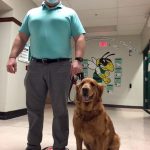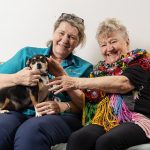Unwanted behavior in dogs is common, with great variance between breeds
April 8, 2020

Unwanted behaviour occurs in many pet dogs.
“In the dataset of nearly 14,000 dogs that we have compiled, one of the largest in the world, unwanted behaviour occurred in 73% of the dogs. One such behaviour trait is noise sensitivity, found in one-third of the dogs,” Professor Hannes Lohi says.
Lohi’s research group investigated the prevalence of seven unwanted behaviour traits: noise sensitivity, including thunder, fireworks and shots; fearfulness of humans, other dogs and unfamiliar locations; fear of surfaces and heights; inattention and impulsivity; compulsive behaviour; aggressiveness; and separation anxiety. In addition to noise sensitivity, fearfulness and fear of surfaces and heights were very common traits.
As in dogs, so in humans
The study also looked into the link between individual traits. As observed in prior studies, fearfulness and aggressive behaviour are often comorbid. Some of the findings were new and surprising.
“We discovered an interesting connection between impulsivity, compulsive behaviour and separation anxiety. In humans, obsessive-compulsive disorder (OCD) often occurs together with attention deficit and hyperactivity disorder (ADHD), but this is the first time the same has been seen in dogs,” says doctoral candidate Milla Salonen.
The behaviour research carried out by the group has another goal: to understand what underlies human mental health problems. Physiologically and behaviourally, dogs are similar to human beings. Furthermore, unwanted behaviour is natural in dogs who also share the same complex social environment with humans.
“With the help of this project and data, we will continue investigating how good a model species the dog is in research focused on human mental health problems. Our previous genetic research pointed to the same genomic areas in fearfulness and noise sensitivity,” Professor Lohi says.
Breed-specific and significant differences in behaviour
The prevalence of unwanted behaviour traits was compared between the 15 breeds with the most responses received in the related survey, with significant differences identified between breeds.
“The problems appear to be quite breed-specific. For example, in Border Collies we observed more compulsive staring and light/shadow chasing, behaviours that occurred more rarely in all other breeds,” Lohi says.
Differences in the prevalence of behaviour traits between individual breeds were manyfold.
“One of the biggest differences among the breeds was identified in fearfulness of unfamiliar people, in which there was an 18-fold difference between the most timid breed and the bravest breed, the Spanish Water Dog and the Staffordshire Bull Terrier,” Salonen explains.
Behavioural research aims to increase canine welfare. Many unwanted behaviour traits, such as fearfulness and noise sensitivity, can cause intense stress in dogs. Behavioural problems may result in the owner giving up the dog.
“Our findings indicate that unwanted behaviour seems to be inherited, which means that, through careful breeding that relies on suitable behaviour indicators, the prevalence of such behaviour traits could be decreased. This would improve the quality of life of not only the dogs, but their owners too,” Professor Lohi states.
Register your Dog Schedule a Visit

 When middle school students return to class on Jan. 11, they’ll find a new face at the door: Daisy. Daisy is a therapy dog and the personal pet of Rob Kreger, principal of the Rock L. Butler Middle School. The five-year-old golden retriever is not a school pet or mascot, but rather a working dog […]
When middle school students return to class on Jan. 11, they’ll find a new face at the door: Daisy. Daisy is a therapy dog and the personal pet of Rob Kreger, principal of the Rock L. Butler Middle School. The five-year-old golden retriever is not a school pet or mascot, but rather a working dog […] Last March, Caroline Benzel, a third-year medical student, began to notice the stress and discomfort her nurse friends were feeling from the pressures of the ongoing Covid-19 pandemic. “[Personal protective equipment] can be really rough on the skin,” Benzel, 31, tells PEOPLE. Benzel and her 3-year-old Rottweiler, Loki (who’s also a therapy dog) hatched a […]
Last March, Caroline Benzel, a third-year medical student, began to notice the stress and discomfort her nurse friends were feeling from the pressures of the ongoing Covid-19 pandemic. “[Personal protective equipment] can be really rough on the skin,” Benzel, 31, tells PEOPLE. Benzel and her 3-year-old Rottweiler, Loki (who’s also a therapy dog) hatched a […] When Stanley the miniature fox terrier’s owner passed away, the little dog started a ‘paw-some’ new role – bringing puppy love to some of the Gold Coast’s oldest residents. After Carinity Cedarbrook Diversional Therapist Julianne Staff adopted Stanley, he began visiting the aged care community at Mudgeeraba as a therapy dog. Therapy dogs help to […]
When Stanley the miniature fox terrier’s owner passed away, the little dog started a ‘paw-some’ new role – bringing puppy love to some of the Gold Coast’s oldest residents. After Carinity Cedarbrook Diversional Therapist Julianne Staff adopted Stanley, he began visiting the aged care community at Mudgeeraba as a therapy dog. Therapy dogs help to […] Those who own a dog can attest to their ability to lift mood, improve stress and bring joy by simply being there, unanswering, seemingly all-knowing and always delighted to see you. Therapy animals are known for their calm and comforting nature, giving people a way to relax, de-stress and interact with a loving pet. They […]
Those who own a dog can attest to their ability to lift mood, improve stress and bring joy by simply being there, unanswering, seemingly all-knowing and always delighted to see you. Therapy animals are known for their calm and comforting nature, giving people a way to relax, de-stress and interact with a loving pet. They […] For those of us with dogs, we know they quickly become major parts of the family. You live for and care for just like one of your own children, and one dog right here in Oklahoma City is beating the odds, and helping others recover as a therapy dog, despite all of the issues he’s […]
For those of us with dogs, we know they quickly become major parts of the family. You live for and care for just like one of your own children, and one dog right here in Oklahoma City is beating the odds, and helping others recover as a therapy dog, despite all of the issues he’s […] Cherokee Middle School students may do a little more “doodling” second semester starting this month (January), but also will improve their attendance marks because of a special attraction at the school, courtesy of Principal Scott Aden. Aden, an effective, caring administrator, has acquired and will house and handle a young female Golden Doodle (Charlie) that […]
Cherokee Middle School students may do a little more “doodling” second semester starting this month (January), but also will improve their attendance marks because of a special attraction at the school, courtesy of Principal Scott Aden. Aden, an effective, caring administrator, has acquired and will house and handle a young female Golden Doodle (Charlie) that […] E5 Therapy opened in April with a different way to help veterans in therapy. They offer canine-assisted therapy along with talk therapy to veterans and veterans’ families in Solano County. Owner Matthew Decker is a licensed clinical social worker in Northern California, focused on helping veterans achieve their mental health goals. Along with his team, […]
E5 Therapy opened in April with a different way to help veterans in therapy. They offer canine-assisted therapy along with talk therapy to veterans and veterans’ families in Solano County. Owner Matthew Decker is a licensed clinical social worker in Northern California, focused on helping veterans achieve their mental health goals. Along with his team, […]